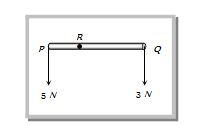Two forces and are at an angle such that the resultant is . The first force is now increased of and the resultant become . The value of is
The correct Answer is:D
then
Now then …(i)
.(ii)
from (i) and (ii) we get
Similar Questions
Knowledge Check
- Question 1 - Select One
Two forces 10 N and 15 N are acting on a body then which cannot be the resultant of these two forces
A25 NB5 NC20 ND30 N - Question 2 - Select One
Two forces each of magnitude 2N, act at an angle of 60∘. What is the magnitude of the resultant force ?
A√2NB√6NC√8ND√12N - Question 3 - Select One
The resultant of the system in the figure is a force of 8 N parallel to the given force through R. The value of PR equals to
 A1/4RQB3/8RQC3/5RQD2/5RQ
A1/4RQB3/8RQC3/5RQD2/5RQ
Two forces of magnitudes P and Q are inclined at an angle (θ). The magnitude of their resultant is 3Q. When the inclination is changed to (180∘−θ), the magnitude of the resultant force becomes Q. Find the ratio of the forces.
View SolutionTow forces Fand2F newton act on a paricle. If the first force be doubled and the secon force be increased by 20N, the direction of resultant is unaltered. Find the value of bigger force.
View SolutionThe resultant of two forces 3P and 2P is R. If the first force is doubled then resultant is also doubled.The angle between the two forces is
View SolutionThe maximum resultant of two concurrent forces is 10N and their minimum resultant is 4N. The magnitude of large force is
View SolutionThe resultant of the system in the figure is a force of 8 N parallel to the given force through R. The value of PR equals to?
 View Solution
View Solution

